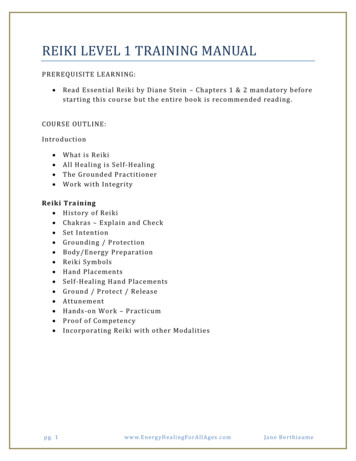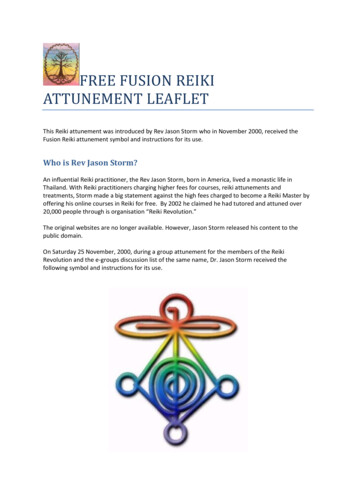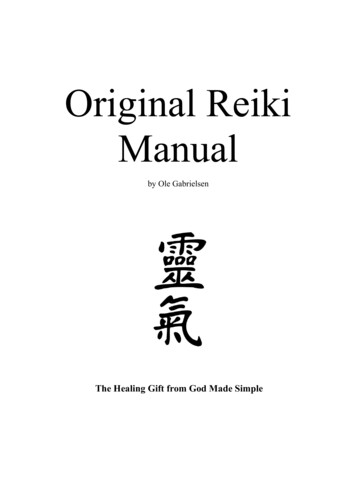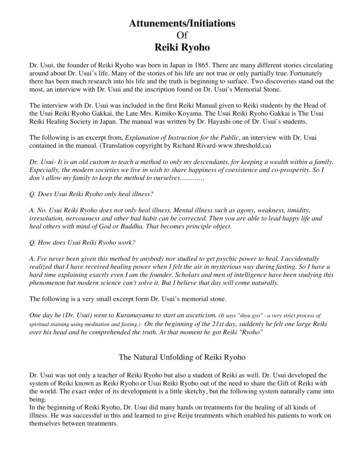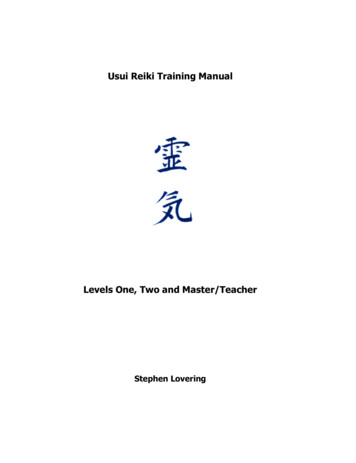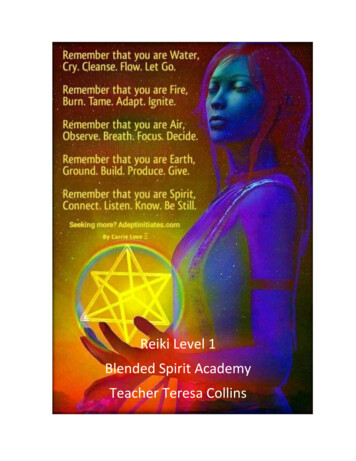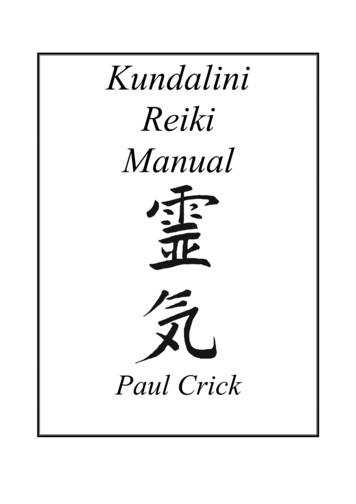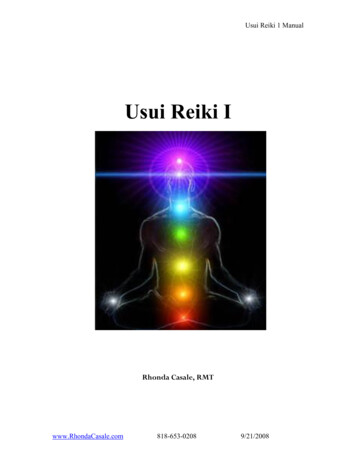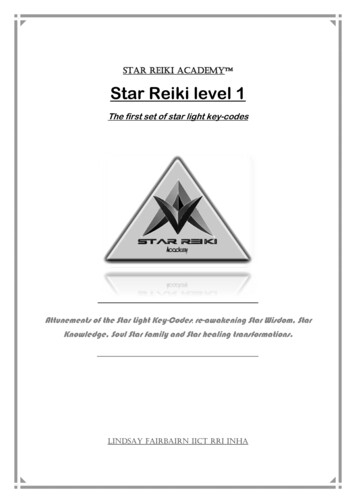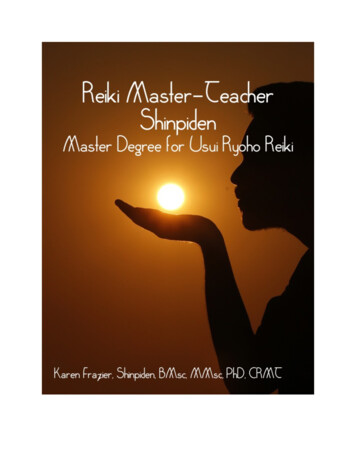
Transcription
Reiki Master-Teacher (Shinpiden) – Master Degree for Usui RyohoReikiBy Karen Frazier, Shinpiden, BMsc, MMsc, PhD, CRMT 2019 Karen Frazier, all rights reserved. No portion of this manual can be reproduced ordistributed without the express written consent of the author.
IntroductionBeing a Reiki Master-Teacher is both an honor and responsibility. As a Master-Teacher, youhave the honor of sharing Reiki with others and the responsibility of teaching and providingReiki in an ethical and responsible manner. As you teach, you will also attune others to the giftof Reiki, sharing with them in your own way the spiritual gifts and responsibilities that comewith it.Although you have achieved the Master-Teacher Degree of Reiki, however, you are still only atthe beginning of this journey. It is up to you to continue your studies and find ways toincorporate this healing energy into your life. As a Reiki Master-Teacher, you will teach byexample, so it is essential you continue to learn and keep incorporating the five principles ofReiki in your life.Reiki is a tool of healing and enlightenment and as a Reiki Master-Teacher, you will continue tohelp spread the energy throughout the world through your teachings and attunements. Livingas a kind, generous, compassionate, and loving person with a genuine desire to help others willserve you well as you share Reiki energy with others.
Chapter One – Choosing to Become a Reiki Master-TeacherYour path to and motivation for becoming a Reiki Master-Teacher is uniquely yours. How youchoose to allow this new designation of RMT to feature in your life is entirely up to you, and Ihonor the path you choose.Becoming a Reiki-Master Teacher with No Intention to Teach or AttuneMany people who obtain the designation of Reiki Master-Teacher have no intention of teachingor attuning others to Reiki. That’s perfectly fine. It was never my intention to become a Reikiteacher. Initially, my interest was personal. I believed I needed to be attuned to Master-TeacherDegree Reiki to serve as an energy balancer in the area I lived; that is, someone whose Reikivibration served the greatest good of my geographical region simply by my energetic presence.For many people, this is a noble goal and a needed service. I believe there are people who livethe places they do and vibrate at a certain energy in order to hold space in a place and to bringsome kind of balance and healing to that place. Reiki energy is a beautiful way to do this.When to Start Teaching and AttuningListen to your intuition. It can guide you as to when you start to teach and attune others toReiki. Your Divine Guidance will tell you when you are ready to begin teaching and attuningothers. Some never teach or attune, they simply wish to work with the advanced Reiki energyavailable through the Reiki Master-Teacher attunement. Others begin teaching right away.Some only work with First and Second Degree students and attunements. Others work withprivate healing partners or friends and family only. Others choose Reiki to work with animals,change the energy of spaces, or include Reiki energy in their other life practices, such as a nursewho wants to channel Reiki when he touches patients or a psychotherapist who wants Reiki asa tool when working with clients.There’s no correct reason to become a Reiki Master-Teacher, there’s just your reason. Thereare as many motivations and methods for incorporating Reiki into one’s life and practices asthere are people on the planet. There is no correct path to Reiki, there’s just your path. Dowhat feels right knowing you are serving the highest good of the universe with your own specialenergy and insight. Your Divine Guidance will help you understand what your Reiki path is. Beopen to what it has to tell you and always be ready to make another choice if your currentchoice no longer serves you.I didn’t intend to teach, but one day I felt called to do just that, and so it’s what I did. Someday.I may be guided to engage my Reiki in a different way, and if I am, I will do that. I encourage youto listen, hear, and adapt in a similar manner based on the guidance you receive.Be Open to GuidanceBe open. Listen during meditation. Pay attention to your dreams. Before you go to sleep atnight, say, “Tell me what I need to know,” and then look for messages. Communicate with your
Reiki guides. If you are drawn in a direction, explore it. Just because you set foot on one pathdoesn’t mean you always need to stay on that path. Some paths are “for now” paths that serveus for a time until they no longer do. Then, we find a new path and move along that oneinstead. This is your spiritual and healing journey, and you have your own unique role to fill inthe universe as a powerful Reiki Master-Teacher.
Chapter Two - Reiki Master SymbolsReiki uses symbols to focus and amplify the Reiki energy, and the use of these powerfulsymbols is what separates First Degree Reiki from Second Degree and Master-Teacher DegreeReiki. With each successive degree, the energy you supply is stronger and more powerfulthanks to the Reiki symbols.In Second Degree Reiki, you learned multiple symbols for strengthening and focusing Reiki,including Cho Ku Rei, Sei He Ki, and Hon Sha Ze Sho Nen. In this degree, you will learn the Reikimaster symbol, Dai Ko Myo.The Reiki Master SymbolThe Reiki Master Symbol is called Dai Ko Myo (dye-ko-me-oh), and the translation roughlymeans “bright shining light,” or “enlightenment.” It is the most powerful Reiki symbol available,and only Reiki Masters who have been attuned to its power can use it. You will receive yourMaster-Teacher Degree attunement to this symbol as part of this course. Once you have beenattuned to Dai Ko Myo (DKM), it will be with you for life.DKM represents love, light, and harmony. It is the Source of all, and the universal energy thatruns through all of us. It is the energy from which we come and to which we return.The symbol balances issues of the body, mind, and spirit. It transmutes negative energy topositive. It can also be used in place of all other Reiki symbols, crossing barriers of space andtime to bring positive energy to situations. Use of the symbol helps you move towards onenesswith Reiki energy.You can use DKM alone or in conjunction with any or all of the other Reiki symbols dependingon what you are intuitively guided to do during a session. As with other symbols, attunement tothem and intention to invoke their power is the key.DKM is also the symbol you will use to attune others to the three degrees of Reiki. It is thesymbol that activates the attunement energy, and when combined with your intention, it helpsyou attune your student to the appropriate degree of Reiki energy.
Drawing Dai Ko MyoThe above strokes illustrate how to draw DKM.DKM Energy in Your LifeOnce attuned to DKM, you may notice a powerful change in your energy and the Reiki energyyou channel. Attunement to and use of the DKM symbol can: Increase intuitive power and psychic energy in your lifeCreate changes in your life and careerHelp manifest your goalsIncrease mental, emotional, and spiritual healingProvide protectionTransmute negativityAttune others to Reiki energyEnergetically set up a healing spaceHow to Activate DKMAs with the other symbols, intention is key in activating DKM. Draw DKM in each of your palms with your index finger.Draw DKM in your mind’s eye and project it into your palms.Draw DKM in your mind’s eye and project it to your subject.Visualize DKM in your palms before a session.Draw DKM in the air and beam it in the direction of your palms.
Draw DKM on the roof of your mouth with your tongue and project it into your palmsand subject.As with the other Reiki symbols, as you are drawing the symbol, silently intone the symbolname in your mind three times to activate it. When you draw it on a healing partner, use themiddle and forefinger of your giving hand to tap it into your healing partner’s body.Using DKMDuring a Reiki session with a healing partner, first activate the DKM in your own hands, andthen project it onto the subject: At the crown chakra In any areas with symptoms or issues Into the hands or palms of the subjectDKM can be used in any situation where you would use any of the other Reiki symbols. You canintone the name or visualize it during meditation to further connect to Reiki until you learn thatthe energy that is Reiki is actually the energy that is you. DKM can help you to understand thatyou and Reiki are one.DumoDumo (due-Moe), which you learned briefly in Second Degree Reiki, is also an important symbolfor the Reiki Master-Teacher. There are two traditional drawings of Dumo; choose one thatworks for you. It represents kundalini energy. Kundalini is an ancient Sanskrit term thatdescribes universal energy and consciousness that has been with you through all of yourincarnated lives. It sits, coiled at the base of your spine, waiting to awaken, uncoil, and moveupward through your body’s energetic systems. It is the source of all life force energy (prana orchi) in your body. Reiki and other energetic practices can awaken kundalini deliberately, or itmay awaken during spontaneous life events. Regardless of how or when kundalini awakens in a
life, it brings many spiritual, physical, mental, and emotional changes that you can channel toserve your highest and greatest good.Many Reiki Master-Teachers use Dumo during the attunement process using a method calledthe Violet Breath (which is one of the methods you will be taught here). Others use it to stokethe fire of kundalini, drawing negative energy out of the body and releasing it. You can also useDumo with crystals. By drawing Dumo on the crystals, they will become self-cleansing.Fire DragonSome branches of Reiki use the Fire Dragon symbol in the attunement process. While Usui ReikiMasters traditionally don’t use this symbol, if it resonates with you are you are drawn to usingit, you may. Like Dumo, Fire Dragon represents the coil of kundalini energy at the base of thespine.This symbol opens and balances chakras, which allows Reiki energy to flow freely through themduring an attunement. If you are providing an attunement to someone who has difficult chakrablockages, this is a good symbol to use. Draw it down the spine of the person you are attuning.RakuRaku (Ray-Koo) may be a helpful symbol during an attunement, although you only need to useit if you feel it is necessary. You can use this symbol to close the energetic connection betweenyou and the student at the end of the attunement because it grounds the Reiki energy. This isespecially helpful if either you or your student is empathic and tends to hold onto energy tiesafter energetic interaction. It is also helpful for you to use in a Reiki session with a healingpartner for the same reason. To use it, draw it down the back of the student, touching the floorat the end to close the energetic connection.You can also use this symbol to increase spiritual awareness and release negative karma.
Chapter Three - Reiki AttunementsThe Reiki attunement ceremony is powerful for both the student and the Reiki Master-Teacher.After the attunement, the student will be able to focus and channel Reiki energy. Thisattunement to Reiki energy lasts a lifetime.It is important to stress to students that Reiki does not make them a healer; rather it allowsthem to become a vessel or channel through which the Reiki energy emerges with its ownintelligence. The subject then draws the Reiki into his or her body as it flows through thechannel.The historic oral tradition of Reiki in the West means that different Reiki masters may teach andprovide different types of attunements. You will be provided with several options in thismanual. Choose the attunement ceremonies that work best for you, knowing that whichceremony you use may be different depending on the student and situation. Any of theattunements will work equally well, and after receiving it, your student will be able to channelReiki energy. You can also intuitively choose or create your own attunement process if there issomething that is meaningful to you. I vary my attunement ceremonies depending on degree ofReiki, what my students indicate they would like, and what I intuitively feel drawn to do.Practice, Practice, PracticeMany people feel awkward when they give their first attunement to a student. You mightwonder if you’ve done the attunement right, if it worked and your student is truly attuned toReiki energy, or if you did anything strange or “wrong” as you attuned your student. There are afew things you can do to build your confidence before you teach that first Reiki class. Offer free Reiki classes and attunements to friends or family until you feel comfortablethe process works. (Trust me, it always works. I’ve attuned hundreds of people andbeen to several other attunements, and I’ve never seen a Reiki attunement not ‘take’).Practice on inanimate objects, such as a stuffed bear or doll.Pantomime practice your various attunements with an invisible personPractice the attunement ceremonies, which have multiple steps, before you provide your firstattunement. That way, your actions can be seamless and flow, making the ceremony morepowerful for your students.Regardless, it’s important to keep this in mind. You can’t do an attunement wrong. Yourintention, your student’s intention, the use of Reiki, and the use of the DKM symbol aresufficient to attune your student to Reiki, regardless of what gestures you use.Requirements for a Reiki AttunementWhile there are different types of attunements and ceremonies, what is truly important is: The use of the DKM symbol to activate your attunement energy Your intention as a Reiki master
Your desire as a Reiki master to provide the energy and attune the student to itOpenness to the transmission of Reiki energy between you and your studentYour student’s willingness to accept Reiki energyDegrees of AttunementsReiki Master-Teachers may attune their students to Reiki in different ways. They may divide the attunements into three separate attunements for First DegreeReiki, Second Degree Reiki, and Reiki Master-Teacher Degree They may combine any of the Reiki degree attunements, for example, providing FirstDegree and Second Degree attunements at the same time, Second Degree and MasterTeacher Degree attunements at the same time, or all three degrees at once dependingon the situation and needs of the student. The way I choose to teach and attune may be different than how you choose to do it.This is fine. Follow your intuition and Divine Guidance to achieve a system that works foryou and your students.However you choose to attune your students, remember this: students must be attuned to FirstDegree Reiki before a Second Degree attunement, and they must be attuned to First Degreeand Second Degree Reiki before a Master-Teacher Degree attunement. You can’t skip degrees,although you can provide attunements to multiple degrees at one time.Working with the DegreesIt is a matter of personal preference whether you attune to a single degree at one time orcombine all three degrees. Different Reiki Master-Teachers do this differently. The informationthat follows is how I choose to attune to the degrees and why.In most cases, I attune to the Reiki degrees separately, allowing my students time to work withthe energy between each attunement. There are some cases where I may combine First andSecond Degree attunements but in general, I prefer to attune to each separately.My Reiki Master taught me it is helpful for the growth and development of the practitioner towork with each Reiki degree for a time before moving on to the next degree of energy, and thisis a practice I agree with. In general, I feel the Reiki practitioner should work with the energy forat least the minimum 21-day detox period after the attunement to familiarize themselves withthat degree of Reiki energy before seeking a higher degree. Likewise, I believe practitionersshould work with the energy even longer, allowing a minimum of three months between eachdegree, or perhaps even more. I personally worked with First Degree Reiki for almost two yearsbefore moving on to Second Degree Reiki, and then I moved on to Master-Teacher Degreewithin about six months. I received my Crystal Reiki Master attunement about six months afterthat. I worked at the Master-Teacher level and studied everything I could find about Reiki andenergy healing for over a year before I began teaching and attuning students. I intuitively knewwhen I was ready both energetically and with my knowledge of Reiki and energy healingpractices.
Reiki energy changes us, but we have to allow time for the energy to manifest changes in ourlives. Reiki Master-Teacher Degree energy provides more profound changes than First DegreeReiki, so if you jump to Master-Teacher Degree right away, you may not have time to integrateand experience the progression of changes that come as you move up the energetic ladder.Taking your time to allow and process these changes helps you to more fully integrate the Reikienergy into your life and spirit. If you do too much, too soon, you may miss out on theimportant lessons that come with the gradual onset of changes. I know everyone is in a hurrythese days to get from point A to point B, but with Reiki, it’s more about the personal journeythan the end result. In fact, there is no end result with Reiki. Instead, the goal is to continue togrow and change as the Reiki energy brings about greater and greater light in your life.With that being said, there’s nothing inherently right or wrong about any Reiki Master’s choiceof how they attune their students or any student’s choice about how she wishes to be attuned.What is important is listening to intuitive clues and allowing flexibility from student to studentand situation to situation. If you allow Reiki to guide your intuition, then you will know what isright for each individual.Before the Attunement CeremonyRegardless of the degree, there are many common elements to all attunement ceremonies.What is different is the intention for each degree and perhaps the rituals in which you engage.Teaching Your StudentsTeach the appropriate material for the degree of attunement. As a teacher, it will be up to youto develop your own manual and curriculum for these classes. However, it is important youprovide your students with as much knowledge as you can impart so they can ethically andresponsibly share Reiki with others.For all degrees of Reiki, you may use my manuals provided you leave them as is with nochanges to headers, content, or authorship.First Degree ReikiIn this class, you will need to create a curriculum and prepare a manual that teaches thefollowing principles (at minimum): Energy What Reiki is Information about the Degrees of Reiki What Reiki does (how it works – that the Reiki practitioner channels it and the healingpartner draws it in) History of Reikio Dr. Mikao Usui
o Chujiro Hayashio Hawayo Takatao Reiki lineage5 principles of ReikiEthicsReiki treatmento Self-healing treatmento Hand positionso Starting and ending a sessiono Groundingo Communicating with subjectsWhat to expect during and after attunementImportance of daily self-healingMeditationYou will also need to attune your students to First Degree Reiki and allow them time in aclassroom setting to practice.Second Degree ReikiFor Second Degree Reiki, you will need to prepare curriculum and material that teaches (atminimum): The three pillars of Reikio Gasshoo Reiji-Hoo Chiriyo Reiki symbolso Cho Ku Reio Sei He Kio Hon Sha Ze Sho Nen Less Common Reiki symbols How to use the symbols Distance healing techniqueso Ethics for distance healingo Sending Reiki through time and space What to expect during the attunement Importance of ongoing self-treatmentPractice time working with the symbols and the Reiki Second Degree attunement should also bepart of your class.You may also wish to include in your Second Degree course and curriculum: Meeting and working with your Reiki guides
Setting up a distance healing Reiki roomInformation about setting up a Reiki practiceImportance of not diagnosingInformation about communicating with healing partnersIntake paperwork and chartingFinancial and legal considerations of a Reiki practiceReiki Master-Teacher DegreeAt the Master-Teacher Degree, it is important before you begin teaching and attuning that youhave a broad understanding of Reiki yourself, and that you are familiar with the Reiki energyand how it manifests in your life and the lives of others. You also need to be strongly rooted inethical Reiki treatment and attunement.For your Master-Teacher Degree classes, you will need to develop curricula and manuals thatcover the following concepts: Reiki Master symbolo How to drawo How to use Other symbols used by Reiki Masterso Dumoo Fire dragon Developing curricula and manuals and teaching Reiki How to perform Reiki attunements to all degrees (including processes) Ongoing educationPreparing the SpaceAfter you have taught your students, it is time for the attunement. It is helpful to prepare thespace by inviting Reiki energy into the room. You can do this in any way that intuitively feelsright, such as: Drawing Reiki symbols in the room Burning incense, palo santo, or sage Having crystals around the room Playing sounds, such as tingshas or a singing bowl Chanting or meditationYou will intuitively understand how to prepare your space. To prepare my space before theattunement ceremony, I do the following: I use a smoldering palo santo stick, incense, or smudge bundle and draw CKR in allcorners of the room, as well as in front of any doorways or windows to invite in Reikienergy.I sit quietly in the center of the room and bring Reiki to the room.
I fill my Reiki room with objects of high energy, such as crystals, plants, and sacredherbs.If I am in a commercial rental space where I can’t burn, I instead spray a Himalayan pink saltspray with lavender and sandalwood essential oils in water around the room and use my crystalwand to draw DKM all around the room.Preparing Your StudentBefore the ceremony, explain to the student what he or she should expect as the attunementprogresses. Tell the student you will be moving around them, touching their hands, drawingsymbols, or any other actions they can expect. If you use the Violet Breath (I don’t, but it mayresonate with you), you’ll want to prepare your student for that, as well. You will also want toexplain to the student about the 21-day detoxification process and what he or she might expectduring this period, as well. Instruct them to drink plenty of water after the attunement and toprovide daily Reiki self-healing treatments.Before your class, you may want to give the student pre-attunement instructions, such as: Refrain from mind-altering substances for 48 hours before the attunement. Eat light and healthy meals for 48 hours before the attunement. Dress comfortably. If it is a distance attunement, advise them to sit in a comfortable position at theappointed date and time.Tell your student he or she might experience during the attunement: Feelings of peace and relaxation Swirling lights Strong emotions NothingWhatever your student experiences is perfectly normal, so prepare them for some possiblethings they may notice. For distance attunements, let the student know that while it is best tobe relaxed and undisturbed during an attunement so he or she can have the full experience, ifthey are disturbed the attunement will still work, as intention is key.Preparing YourselfIt is helpful to prepare yourself before the attunement process, as well. You will be moving inand around your student’s space, so be sure you have practiced good hygiene and are cleanwith fresh breath. Give the student a break for a few moments so you can prepare bymeditating for five minutes, inviting the Reiki energy in. Before an attunement I do thefollowing: I make sure I have meditated and done Reiki self-healing the day of the attunement. Before the attunement, I draw DKM on both palms and sit in Gassho for at least fiveminutes, or until I feel ready.
I ask my Reiki guides for guidance about any special steps that need to be incorporatedduring the ceremony.The Attunement CeremonyOnce prepared, you may proceed with the attunement ceremony. Below, you will find severalmethods by which you can perform the ceremony. All are equally effective, so choose thatwhich works best for you and your students. Feel free to adapt and create your ownattunement ceremony, as well.Getting ReadyHave the student remove all jewelry, shoes, and glasses (and you may do the same). Seat yourstudent (or students) in a chair with their feet resting comfortably on the floor. Have thestudent(s) place their hands in front of their chest in prayer position and sit with their eyesclosed. Instruct students if they get tired holding their hands in prayer position, they can lowerthem to their lap while you attune other students, and you will lift them to their heart chakrawhen it is time. If you like, you can have gentle music playing during the attunement, but keepit quiet and in the background so the students focus on the ceremony and not the music. Havea glass of water ready for each student either under their chair or on a nearby table for afterthe attunement.Attuning a GroupIf you are attuning a group of students, place chairs in a circle and leave plenty of room to foryou to be able to walk all the way around them. If it is a particularly large group (I once had 50students to attune), bring them into the room in groups. When I have larger groups, I usuallyask one of my Reiki Master-Teacher former students to come help me attune so people aren’tsitting for ages.EquipmentYou don’t need any equipment to attune your students, but if you have something of specialpower or significance, you can use it. If you’ve been attuned by me, you are likely aware I hold acrystal wand called a Vogel crystal that combines sacred geometry and the power of crystals. Ihold it in my receiving hand and transfer it to my giving hand to draw Reiki symbols during theattunement. I feel it brings extra power to my attunements. I also wear Vogel crystals calledTools for Evolution during the attunement to increase connection and power.Special Techniques – Hui Yin and Violet BreathSome practitioners use the violet breath and hui yin techniques for attunement. These areoptional, but you can try them for your attunements if you wish. I prefer not to use them, butthey may resonate with you, and I’d like you to know how to do them in case you wish toincorporate them into your ceremonies.
Hui YinContracting your Hui Yin during an attunement can help to keep your Reiki energy focused andwithin your body during an attunement. The Hui Yin is a point on your body between your anusand genitals. Some practitioners keep this point contracted and their tongue placed on the roofof their mouth throughout attunements. It is up to you whether you feel this practice will helpduring your attunements.If you do wish to keep your Hui Yin contracted, then you will want to practice to work up to thislevel of muscle control. Traditional Kegel exercises can help you develop this level of control.The Violet BreathTo perform the violet breath:1. Visualize a white mist surrounding you completely.2. Contract your Hui Yin and put your tongue behind your upper teeth.3. Take a deep breath in and see a white light entering through your crown chakra,traveling through your tongue, down your body, and circling through the Hui Yin andback up the spine into your head.4. Now see the white mist filling your head. See it turn blue and then indigo.5. Visualize the mist swirling in your head in a clockwise rotation and turning violet as itdoes.6. Now, in the middle of the mist, visualize a golden Dumo. Blow the Dumo symbol andviolet breath into each of the student’s chakras where indicated during the attunementceremony, silently intoning the name of the symbol three times as you do so.Elements of an AttunementIn an attunement for any degree, you’ll need to include the following elements.PreparationIn the prep section, explain to your students what they will experience. Tell them you aresending them out of the room for five to ten minutes while you prepare the space and yourself.Suggest they use the time in thoughtful meditation or to quietly speak to the universe to offertheir unconditional acceptance of the attunement they are about to receive. Tell them whenthey return to the room to file in quietly and have a seat in their chair with their hands in prayerposition (Gassho) at their heart and their eyes closed. Tell them you will touch them on theshoulder when their attunement begins and will move about them, touching them and possiblyraising, lowering, and opening their hands. Ask for permission to touch. If you don’t receive it,you can still attune, but just do so a few inches from their bodies.Also, if you are working with a large group of Reiki students, you need to know their names. Ifyou’ve been in one of my larger Reiki classes before, you might have noticed I label you (giveyou nametags). While I do my best to learn people’s names in a class, I always want them tohave a nametag on during the attunement just to be sure I get it right.
Now, send the students out of the room. Do your preparation including drawing DKM on bothof your hands. Then, signal them quietly back into the room. You can do this by speaking tothem, or by ringing a chime or singing bowl. If you are going to use the chime instead ofspeaking, let them know to expect this. Also remind them as they sit down to silently affirmtheir intent to receive an attunement to become a degree Reiki practitioner.Statement of IntentionAttune each student one at a time, worki
Reiki uses symbols to focus and amplify the Reiki energy, and the use of these powerful symbols is what separates First Degree Reiki from Second Degree and Master-Teacher Degree Reiki
